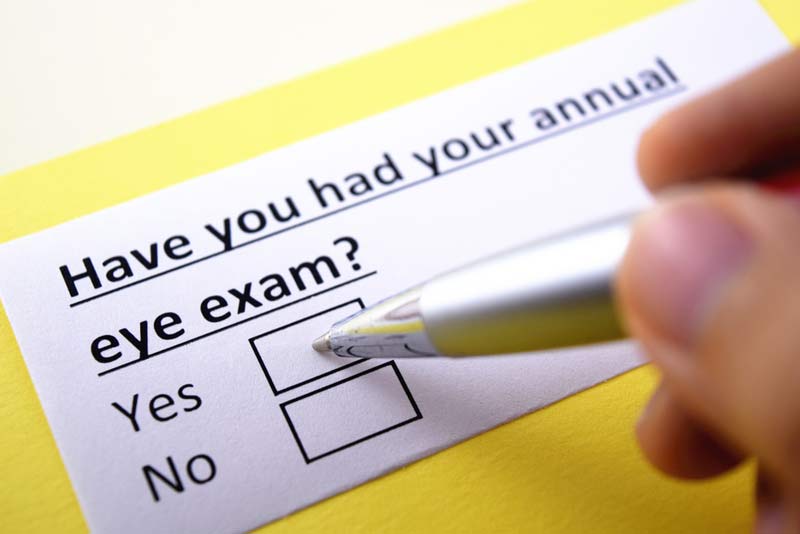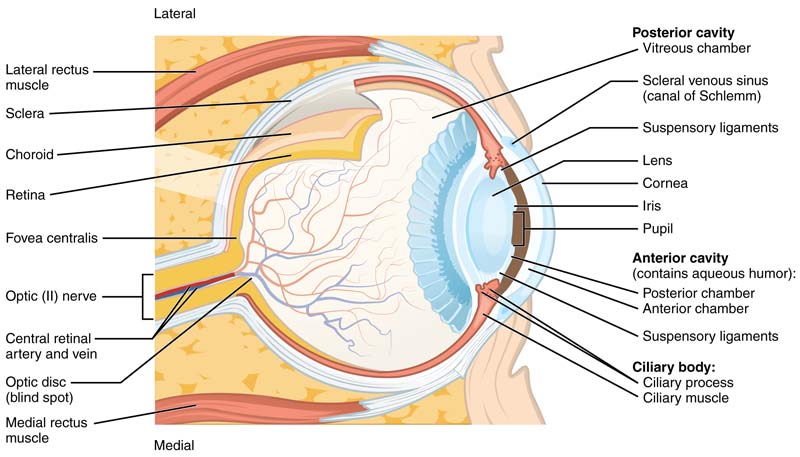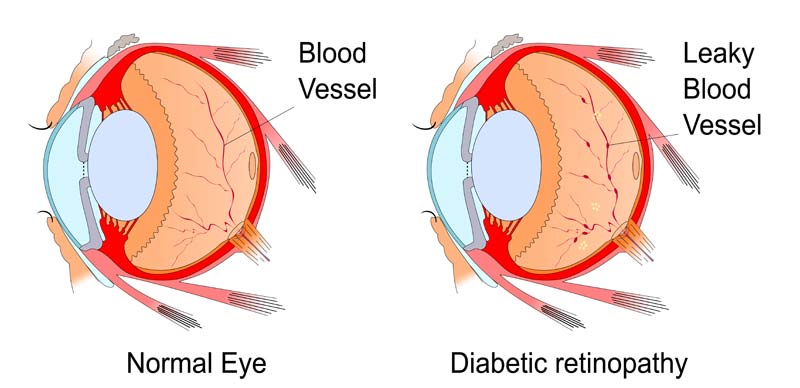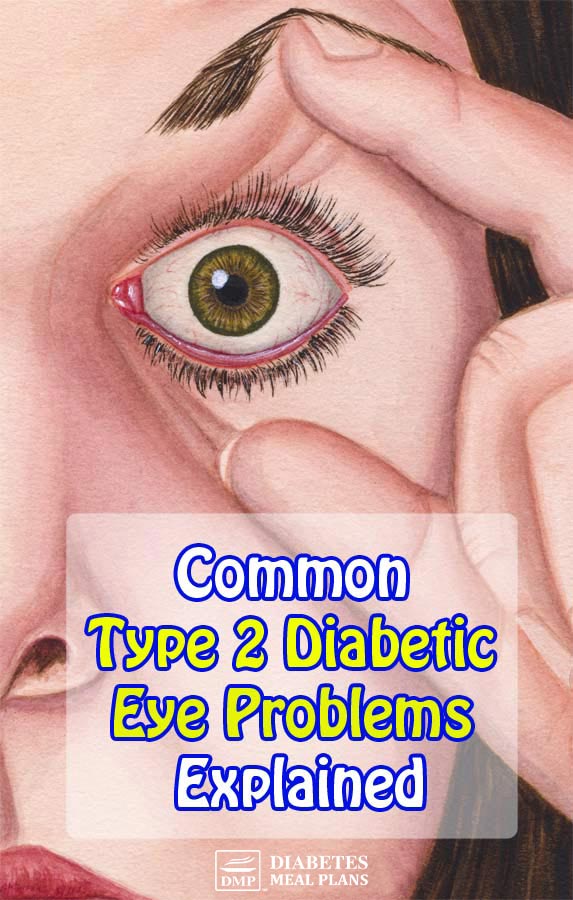It’s never nice to talk about potential complications that can occur, but the reality is, it’s best to be informed.
Among the many complications that type 2 diabetes puts you at risk for are a range of eye problems and eye damage.
Diabetes is the leading cause of blindness, which can be scary, but remember that good glucose control goes a long way in terms of prevention. The more you can keep your blood sugar levels within a healthy range, the less likely you will develop complications.

Besides blindness, additional eye problems include: retinopathy, glaucoma and cataracts.
Before we dig deeper into each eye problem, let’s take a look at how the eyes work so you can understand how problems develop. Then we’ll look at how the eyes can be damaged by diabetes, and what you can do to prevent or treat eye problems.
Understanding Eye Anatomy
The eye is basically a ball covered in a clear membrane. The front curved part is called the cornea–this protects the eye.
When light comes in through the cornea, it passes through the anterior chamber, the pupil (the hole or dark spot in the middle of the colored iris), then hits the lens which focuses the light.

It continues to pass through the center of the eye and hits the back, which is called the retina. The macula is a specific part of the retina that is needed to see fine detail. The retina then focuses the images, records them, and sends them up to the brain via the optic nerve for interpretation.
The eye in general, and especially the back area near the retina are saturated with tiny blood vessels, which supply it with nutrients to stay healthy.
Retinopathy
Retinopathy is the most common cause of vision loss in those with diabetes. Retinopathy refers to damage to the retina resulting in leaking or bleeding blood vessels.

Nonproliferative retinopathy occurs when capillaries in the back of the eye expand and form pouches. These are called microaneurysms and are very common. These will inevitably occur in most people with diabetes, if they live long enough.
As this progresses, blood vessels become blocked and vision degrades. Over time, these blood vessels can close off completely leading to “proliferative retinopathy.”
Sometimes new blood vessels form, but they are usually weak and can easily hemorrhage or allow scar tissue to grow. This scar tissue can distort the retina and even pull it out of place, which is called retinal detachment.
Macular edema (swelling) is a type of retinopathy that occurs when fluid leaks into the macula (part of the eye that involves focusing) and it swells, causing vision to blur. If treated early, macular edema can be halted and even reversed.
Cataracts
Cataracts is a condition where the clear lens of the eye (behind the iris and pupil) becomes cloudy, which blocks light and impairs vision There are several types of cataracts depending on where they occur in the lens.
While cataracts are common, especially with increasing age, people with diabetes are 60% more likely to get cataracts.
Glaucoma
Glaucoma is a condition where pressure builds up in the eye. This results in pinched blood vessels, which cuts off supply of nutrients to the retina and optic nerve (the nerve that connects the eye to the brain).
Over time, the tissues become irreversibly damaged leading to a loss of function of the retina and nerve.
Risk of glaucoma is 40%-50% higher in those with diabetes.
Diabetic Eye Exam
When you visit an optometrist (healthcare professionals providing primary vision care including vision testing and treatment) or ophthalmologist (medical doctor specializing in eye and vision care), they may perform a variety of tests including:
- Visual acuity testing: Uses an eye chart to measure your ability to see at various distances.
- Tonometry: Measures pressure inside the eye.
- Pupil Dilation: Drops are placed in the eye to widen the pupil allowing for examination of the retina and optic nerve.
- Optical Coherence Tomography: Uses light waves to capture images of the tissues in the eye.
- Fluorescein angiogram: Performed when eye damage is evident, this uses a dye injected into the bloodstream to detect leaking or damaged blood vessels.
Treatment for Diabetic Eye Problems
The most important thing to remember about treatment is: the earlier it takes place the more successful it will be.
Medications (oral, injectable or eyedrops) and/or surgery can reduce pressure in the eye and/or drain excess fluid.
Cataracts can be treated through removal of the lens (although this can sometimes worsen retinopathy or lead to glaucoma). Or surgical lens transplantation can be conduted (they remove the cloudy one and replace it with a clear one).
Treatments for retinopathy include: photocoagulation, focal photocoagulation and vitrectomy.
Photocoagulation is when lasers burn small marks on the retina causing blood vessels to stop growing and stop leaking. Another type called “scatter photocoagulation” involves searing hundreds of little spots all over, which can prevent hemorrhaging or detachment – if the disease hasn’t progressed very far.
Focal photocoagulation is a procedure where lasers are focused just on the macula. If the retinal has already detached, a procedure called vitrectomy can remove scar tissue and cloudy fluid from the eye, which can save and restore vision. If this doesn’t work, trying to reattach the retina is an option, but works in only about 50% of the cases.
Please pin, tweet or share this info; then keep reading.

Prevention of Diabetic Eye Problems
The most important prevention treatment to reduce your risk of all types of complications is: keep blood sugar and blood pressure in healthy goal ranges.
When blood sugar levels run high it causes damage to blood vessels throughout the body. The longer and higher your blood sugar and blood pressure have run, the greater the risk for eye problems.
Quite simply, excess glucose in the bloodstream damages blood vessels, as does greater pressure on those vessels.
Therefore, following a healthy balanced diet, exercising regularly, maintaining a stable weight and taking appropriate medications, are all ways to regulate glucose and blood pressure.
NOTE ON EXERCISE: If eye problems are already underway, it is important to discuss appropriate eye care with your provider. Strenuous exercise like weight lifting can increase pressure and worsen eye problems if there is already damage.
Aside from blood sugar regulation and lifestyle changes, be sure to schedule a dilated eye exam at least annually. Depending on your particular condition, it may be necessary to have more frequent visits.
If you have the beginning stages of any of the diabetic eye problems listed above, the earlier they are treated the better.
It’s important to realize that, most damage begins occurring before there are any signs or symptoms. Nearly 50% of people with diabetes have retinopathy, but only about half are aware of it.
In addition to annual exams, be sure to schedule an appointment with an optometrist or ophthalmologist if you have any changes in vision, notice any floating spots or blurriness, or have any pain or discomfort – including headaches.
Wearing sunglasses and glare control lenses can help provide protection in those with cataracts. Wearing appropriate corrective lenses (glasses or contact lenses) as needed will help keep eyes from straining.
Prevention is better than cure, so focus on following a healthy balanced diet, exercising regularly, maintaining a stable weight and taking appropriate medications where needed. These will all regulate your glucose and blood pressure levels to help avoid potential complications.
Please pin, tweet or share this info to help others. Thanks!


Consuelo
When contour of eye is inflamated, NIT the eye it self. What is it?
Dr Jedha
It sounds like you’re asking a specific question about a condition you may have Consuelo and the best person to ask for advice is your medical doctor or specialist.
Brannon
What you failed to mention that a diabetic can get piertinal membrane of which I have just been diagnosed with in my right eye.
stephen Hall
Q hello no my name is Steven Hall I type 2 diabetes diabetic I live in Leatherhead England I have an HGV licence I went for a driving job the other day and my eyes my eyes were blurred I couldn’t read another 60 yd number plate on the on the post are there any better ways of treating your eyes I’m having injections at the moment at the hospital I’ve had 10 to 12 she got an HGV medical coming up up and see if there’s any comments about two people thank you
Jedha: Nutritionist (MNutr)
Hi Steven. It’s best to discuss treatment with your doctor or specialist for this type of thing. They are the only ones to provide sound advice based on your personal history. Good luck with it.
Jane
My husband developed retinopathy and now has gone laser therapy, has been operated for retino detachment and silicon oil in situ. Hoping his vision will improve. His vision both eyes is very poor. Observes diet, on diabetic medication. It’s very painful to see what he’s going through.
Jedha: Nutritionist (MNutr)
Sorry to hear that Jane. Our best wishes are with your husband.
Nancyc2450
I am diabetic. I occasionally get a white stringy substance in my eyes that interferes with my vision. I have mentioned it to my eye doctor but he doesn’t seem too concerned about it. He did say I was starting to get cataracts. I will be 70 this year. Do you have any idea what is causing the stringy substance and what I can do about it. The Dr. said to use Tears eyedrops but they don’t seem to help it.
Jedha: Nutritionist (MNutr)
Sorry Nancy, we aren’t eye experts here. If you’re still concerned, speak to your doctor again and if you’re not happy with what one doctor says it can help to consult with another. Good luck.
Igede Dony
I Consumed Moringa Powder for curing my Eye, on Diabetic type 2.
Karen Parchman
Thank you for your information. I will be seeing a eye specialist asap. God bless you
Melinda
My eyes stay bloodshot. Can this be a sign of something serious?
Jedha: Nutritionist (MNutr)
No necessarily, but if you are concerned you should consult with your doctor.
Vicky from Pennsylvania
Is it necessary to have a A1C below a 6.0 to have an eye examanation??
Emily - Dietitian (MS, RD)
A yearly eye exam is recommended for everyone with diabetes, regardless of your A1c level. Obviously the lower your A1c the less likely you are to have eye problems, but it’s still recommended to get a check-up once per year or as directed by your doctor.
Melody Timm
I am seeing a doctor about my eyes. My left eye is like looking through fog. I’ve had a laser and fluid extraction. It has cleared up. But again my vessel burst again. Fluid again was extracted. Again I cannot see again. My sugars are around 200 I am seeing a diabetic doctor now and taking classes for diabetes. Should I go see another doctor. Or stick with the one I have. This seems to be an ongoing thing. In time will my eye heal and I will see again. I know a lot of factors run into this which I’m trying to make this short and simple. Any advice, or questions to ask my doctor.
Emily - Dietitian (MS, RD)
As long as you feel like your doctor is doing a thorough workup and is addressing the severity of your concerns, then I see no reason to switch. You will definitely need medical advice from an optometrist to ensure this gets taken care of ASAP before worsening.
Moving forward it is crucial that you gain better control over your sugar levels to prevent further diabetic complications. I would suggest doing a diet check-in, and make sure that you are consuming lots of vegetables and protein throughout the day. You can check out this list for some other good foods to include. Ideally you want to aim for under 100 mg/dL in the morning, and under 140mg/dL throughout the day.
RL
I cannot thank you enough for all of your valuable information.
With deepest regards,
Roberta in Florida